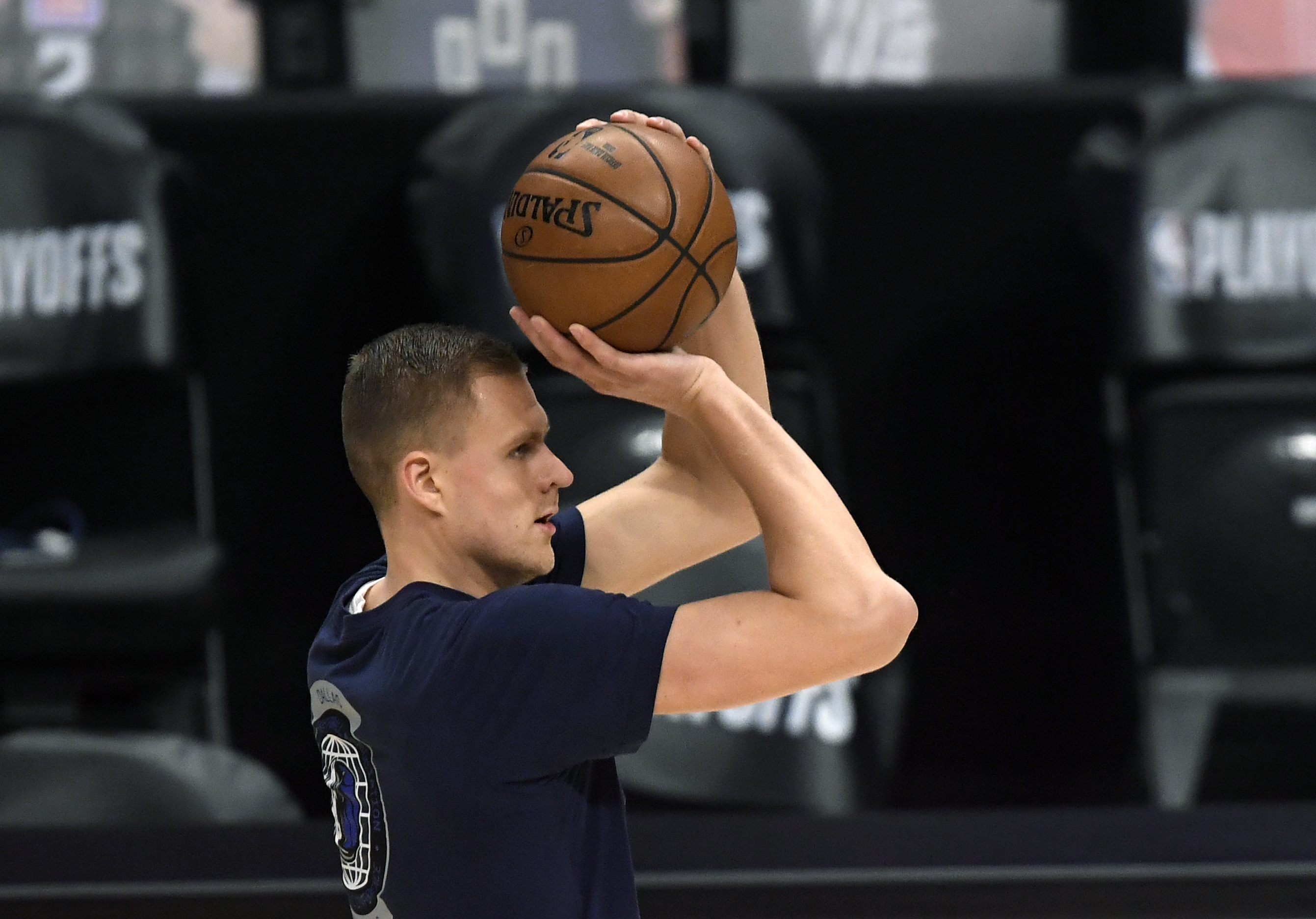The play from Sunday's Game 7 that will stick forever in the minds of many heartbroken Mavericks fans came midway through the second quarter, with the Clippers leading and Dallas's offense showing early signs of the bogging-down that afflicted it in second halves throughout the series. Luke Kennard made a careless pass to the wing and Kristaps Porzingis, switched onto Kawhi Leonard, broke on the ball and made what at first looked like a clean pick-six type of interception. Porzingis had the ball, a live dribble, a full head of steam, a sprinting teammate to his left, and only the extremely not imposing Kennard between him and the bucket.
7-foot-3 Kristaps Porzingis with the steal and... fast break 3?! 😱pic.twitter.com/IK8RCKRCTw
— ClutchPoints (@ClutchPointsApp) June 6, 2021
There's a split second there, with the ball hanging in the air and Porzingis posed red-handed at the spot of its release, where his pull-up three-pointer, whatever your aesthetic preferences, is neither a good decision nor a bad one. There was a time, and not all that long ago, when taking a pull-up three-pointer so early in the shot clock in a playoff game would've been considered an act of lunatic sabotage. Short-circuiting a two-on-one for such a shot and missing it might've gotten you strangled by your own head coach. Doing it as a 7-footer could've landed you in federal protection.
But shooters are real good now, and anyway the NBA world has figured out what to do with the fact that three is half-again better than two. The pull-up three-pointer in transition isn't just a normal shot now; in fact, it's in many cases the best one. If Damian Lillard can walk into a clean pull-up jumper anywhere inside of half-court, he would be making a mistake to not shoot it. But most of what makes Damian Lillard Damian Lillard is that very few other players are also Damian Lillard. Porzingis has deep range and can for sure knock down a pull-up three-pointer, but the math that makes that a terrific shot for Lillard is less clear in Porzingis's case: He's a career 36-percent three-point shooter, and he made less than 35 percent of his pull-up threes this season, on very low volume. His percentages drop precipitously—as you'd expect of anyone and especially a seven-footer—the more dribbles he takes prior to shooting and the longer the ball is in his hands. Kristaps Porzingis, bless all 7-foot-3 of him, is not Damian Lillard.
So, uhh, what the hell is he? Porzingis's game has moved steadily and consistently further and further away from the bucket over the course of his NBA career. His sophomore season, when it was still possible to imagine him one day becoming the best player on a contender, was the last time he took as many shots at the rim as from beyond 25 feet. Offensively he is fully a guard now. The Clippers, tired of getting dragged into unfavorable matchups with Luka Doncic, finally shelved their own bigs after Game 5 and went almost exclusively with small-ball lineups. Scanning Dallas's roster, you would think the skilled 7-foot-3 guy who scores 20 a game would make this shift suicidal, but instead the opposite is true: With his increasingly Kyle Korver-esque shot profile and painfully obvious discomfort with physical interior play, the guy most neutralized by a sturdy all-wing lineup is the humongous Latvian. Defending Porzingis with a guard doesn't summon his beastly inner big man; he just becomes the slower guard in his matchup, a three-and-D wing whose D is wiped out by a center-of-gravity that is too high for the gig by a full 18 inches.
The Mavericks don't have the wing depth to match the Clippers in a small-versus-small matchup. No one does. Head coach Rick Carlisle elected instead to go big, and to use his team's height advantages to neutralize and punish Los Angeles's undersized lineups. Because Porzingis is uncomfortable functioning as a big guy, this meant leaning on fellow giant Boban Marjanovic, who in most situations is limited to low-leverage spot duty. Marjanovic is too skilled to be considered an outright gimmick, but you'd expect most teams to use screens and ball and player movement to exploit his general lack of mobility, especially across a playoff series. Stationing him on the interior means a lot of entry passes and a lot of offensive rebounds, but it also puts a cap on what the offense can accomplish, it takes the ball out of Luka's hands, and it means too often you've got a lumbering 7-footer chasing around perimeter guys at the defensive end. The math of it barely works under the best of circumstances, in large part because those perimeter mismatches can open up a lot of three-point opportunities for the opposition. Against the Clippers, who shot better than 41 percent from beyond the arc this season as a team, you're very much playing the long shot.
The Clippers are going to force a lot of this in their second-round series and beyond, by just having a lot of serviceable perimeter guys who can guard a couple positions. After the ongoing employment of Kawhi Leonard, who rules, that's the real strength of their roster. But there's a universe where they got squashed flat in their opening-round series by a Mavericks team that employs the NBA's two tallest players, where versatility and perimeter skill was wiped out by the fundamental advantage in the sport, which is just being able to reach higher than the other guy. Unfortunately, in our universe that advantage was undermined by a seven-footer who somehow plays with even less functional height than DeJuan Blair.
Someone gotta tells Kristaps Porzingis that he's not Steph Curry... pic.twitter.com/mjLhBfXp5n
— FlightMike (@TheFlightMike) June 6, 2021
Fair or not, Porzingis's shrinking act across this series will be centered as the defining failure of Luka's supporting cast. The Mavericks didn't need so much more than they got from their available players in order to upset the Clippers. Small-ball created an opportunity for Porzingis to literally and in all other ways tower over the competition, and what he produced was a measly 10 points and seven rebounds a night over the final three games of the series, and more than twice as many attempts from beyond the arc as from the stripe, and instead of performing like the best player on a contender, he was a disappearing role guy on an also-ran. There's no rule that says a seven-footer can't be Damian Lillard. By all means, take the pull-ups. Just as there's a universe where Porzingis plays like a big guy, there's one where he makes his heat-checks. But it wasn't this one.





